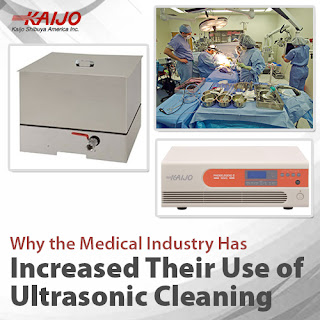Safe medical practices require a high degree of cleanliness. That's why medical instruments, implants, and other medical devices have to be cleaned thoroughly before use.
Medical instruments and devices may have been contaminated with bodily fluids, while implants may have manufacturing residues that have to be removed. Ultrasonic cleaning uses microscopic cavitation bubbles to break up and dislodge surface contamination quickly and thoroughly.
Medical ultrasonic cleaners work by generating microscopic cavitation bubbles throughout the cleaning bath. When these bubbles collapse, they emit a tiny but powerful jet that dislodges dirt and contamination from the devices' surface to be cleaned. The millions of the tiny cavitation bubbles produce an intense scrubbing action that leaves device surfaces completely clean.
Traditional cleaning methods such as manual cleaning and soaking the parts in chemicals can be time-consuming, costly, unsafe, and, most of all, won't produce the same complete cleaning results as an ultrasonic cleaner does. The traditional cleaning process may also require constant monitoring. Manual cleaning and scrubbing of sharp objects can cause puncturing wounds or cuts, and the process can take a lot of time and effort. Not to mention that manual cleaning can be difficult, especially if the device has complex shapes or hard-to-clean openings and crevices.
On the other hand, soaking the parts requires chemicals that have to be purchased, stored, delivered, and (when they're no longer needed) disposed of properly. These harsh cleaning chemicals can pose a significant environmental hazard if not handled properly.
Many of these medical tools and devices are delicate that they cannot withstand high temperatures. For instance, cleaning them with hot water may cause damage and, in turn, compromise their efficiency. Optical devices such as parts of fiber optics may have delicate surfaces that manual scrubbing can damage them. Medical ultrasonic cleaners can be designed to deal with these issues and thoroughly clean fragile electronic and optical devices
Ultrasonic cleaning, therefore, may help address these issues. The parts are placed in a basket immersed in the cleaning bath that can be plain water or solution with only mild detergent or disinfectant. After a timed period of ten to twenty minutes, the clean parts can be removed from the bath. No manual cleaning or scrubbing, use of chemicals, and supervision of the cleaning process are needed. The result is clean objects that can be sterilized without fear that hidden contamination may protect microbes and pathogens against sterilization.
For more details read the article, “Why the Medical Industry Has Increased Its Use of Ultrasonic Cleaning”. As a leader among ultrasonic cleaner manufacturers, Kaijo Shibuya provides extensive experience with a broad product line and outstanding customer support to address your industrial cleaning requirements. Contact them at info@kaijo-shibuya.com or call 408-675-5575.


No comments:
Post a Comment